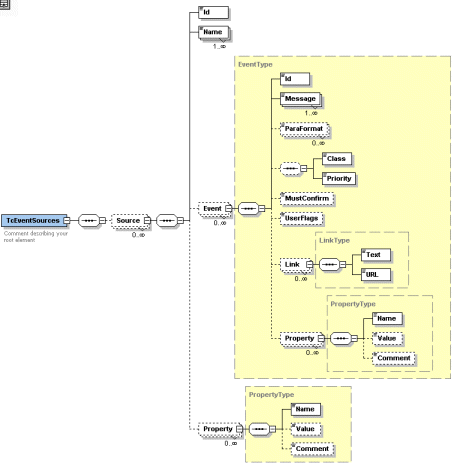XmlEventConfguration
The file XmlEventConfguration defines the event configuration of a Source Id in different languages. The XmlEventConfguration Source Id and the location must be added to the TcEventSourceLocation as a Location node.
Scheme
The following screenshot shows a XML scheme with the structure of the XmlEventConfguration xml file.

The following table describes the nodes of the XML file
Interface | Description |
|---|---|
TcEventSource | The only root element, it contains a list of Source nodes from 0 to infinite. |
Source | Sub element of the TcEventSource node. This node is the configuration of a Source. The sub elements are Ids of the Source. 1 to infinite for the Source Name in different languages and 0 to infinite for the Events and Properties. |
id | Sub element of the Source node. An Intger with the Source Id. |
Name | Sub element of the Source node. The Source Name for the different languages. The language is defined by the attribute *LcId. If no *LcId attribute exists, the *LcId 1033 (US-English) is used. |
Event | Sub element of the Source node. This node is the configuration of a Event. The sub elements are Event id. a Message string for the different languages from 0 to infinite, ParaFormat is the format string for the Event data, the MustConfirm flag, the UserFlags, DocLinks from 0 to infintie and Property fron 0 to infinite. |
Property | Sub element of the Source node. The property is displayed by name, value and comment. |
id | Sub element of the Event node. A Integer with the Event Id. |
Message | Sub element of the Event node. The Event message for the different Languages. The language is defined by the attribute *LcId. If no *LcId attribute exists, the *LcId 1033 (US-English) is used. The eventData was assigned when the Event was started from the PLC module ADSLOGEVENT by setting the Flag from FALSE to TRUE or by calling the function ITcEventLogC::ReportEvent, ITcEventC3 ::ReportEventEx or ITcEventLog:: ReportEvent. It can added to the message with %1, %2, %,3 ... , %x is the number of the index of eventData. |
ParaFormat | Sub element of the Event node. Defines a printf format description, that is used for eventData. The attribute ParaNo represents the Index of eventData for that the format string is used. |
UserFlags | Sub element of the Event node. An integer that defines the user-defined flags. |
Link | Sub element of the Event node. A DocLink is a link to a document that offers more informations in different languages. You can access to the DocLink Porperty with the TcEvent object ITcEvent:: EnumDocLink and in the context menu of the TcEventViewer. The language is defined by the attribute *LcId. The DocLink has a sub element Text that shows the URL for the requested *LcId. |
Property | Sub element of the Event node. The Property element has a Name, a Value, and a Comment. |
Example
The following text shows a example of a XmlEventConfguration file.
<?xml version="1.0" encoding="UTF-8"?>
<TcEventSources>
<Source>
<Id>1</Id>
<Name LcId="1033">Axis Controller</Name>
<Name LcId="1031">Achsen Controller</Name>
<Event>
<Id>1</Id>
<Message LcId="1033">The Axis:%1 stop at the position %2
mm</Message>
<Message LcId="1031">Die Achse:%1 hielt an der Position %2
mm</Message>
<!-- format for the second parameter -->
<ParaFormat ParaNo="2">%.3f</ParaFormat>
<!--the event class and prio is defined here -->
<!-- the event class is a WARNING-->
<Class>6</Class>
<!-- the event priority is implicit -->
<Priority>0</Priority>
<MustConfirm>true</MustConfirm>
<Link LcId="1033">
<Text>Help</Text>
<URL>file:///C:/1033/AxisError.html</URL>
</Link>
<Link LcId="1031">
<Text>Help</Text>
<URL>file:///C:/1031/AxisError.html</URL>
</Link>
<Property>
<Name>Log</Name>
<Value>true</Value>
</Property>
</Event>
<Event>
<Id>2</Id>
<Message LcId="1033">Emergency Stop!</Message>
<Message LcId="1031">Not Stopp!</Message>
</Event>
</Source>
</TcEventSources>
This example shows the Event configuration for 2 Event with the languages German and English.
The following table gives a list of some language *LCIDs.
LCID | Description |
|---|---|
1031 | German |
1033 | US English |
1034 | Spanish |
1036 | French |
*LCID: more information in the MSDN Library.